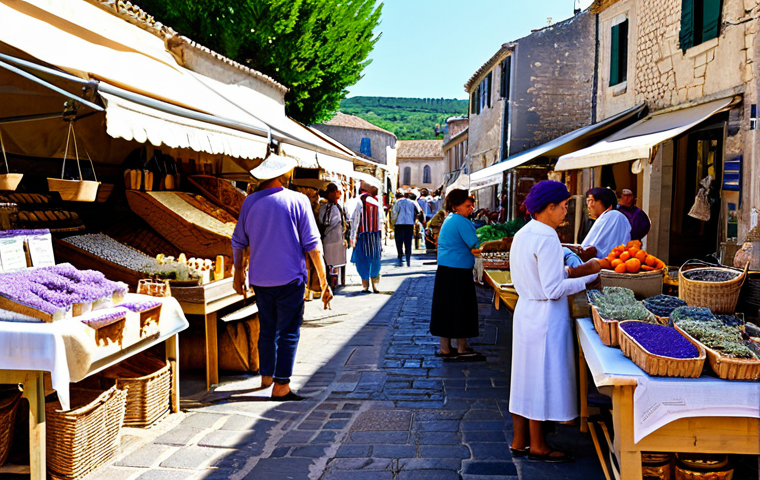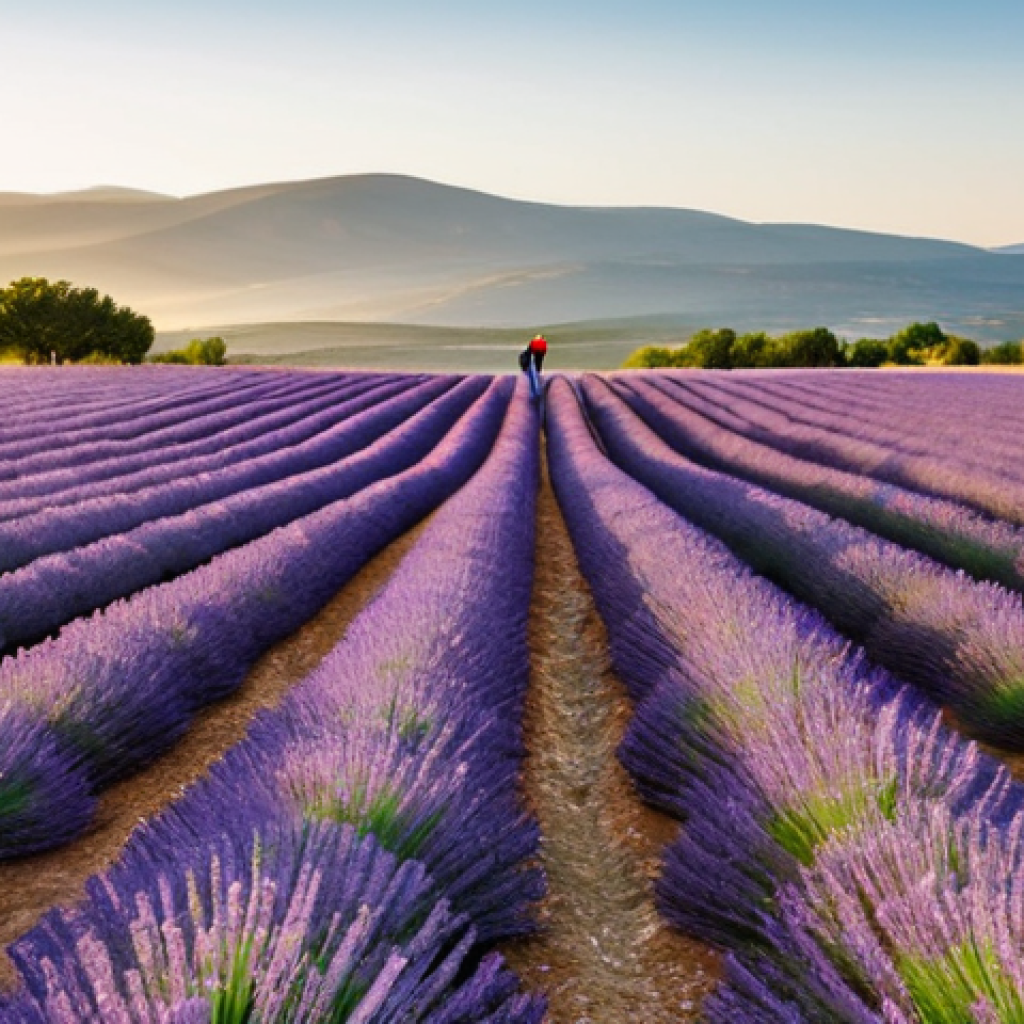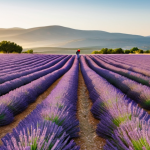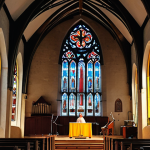The first time I stepped onto a lavender field in Provence, it wasn’t just a sight; it was an entire symphony for the senses. That unmistakable, calming aroma, the vibrant hum of countless bees, and the endless undulating purple stretching under the bright Provençal sun – it’s an experience that truly lodges itself in your soul.
I remember thinking, “This is even better than the postcards!” Yet, as these stunning fields have surged in popularity, especially with the rise of visual platforms, planning that perfect, serene visit has become a more nuanced affair.
You’re not just looking for beauty; you’re trying to find that quiet moment amidst growing numbers, navigating everything from optimal bloom times that seem to shift subtly each year due to climate patterns, to finding those less-trodden paths away from the main tourist hubs.
It’s about preserving the magic, not just observing it. If you’re dreaming of your own idyllic lavender escape, understanding the current landscape of Provençal tourism and leveraging insider tips is crucial to transforming a hopeful trip into an unforgettable memory.
Let’s delve into the details.
Mastering the Lavender Calendar: Timing Your Visit for Peak Bloom

When I first planned my Provençal lavender adventure, I naively thought “summer” was enough of a guide. Oh, how wrong I was! The truth is, the magic of the lavender fields is incredibly fleeting, and pinpointing the absolute best time is less about a broad season and more about a precise two to three-week window that dances around June and July.
This isn’t just about seeing purple; it’s about experiencing the fields at their most vibrant, before the harvest begins, when the air is thick with that intoxicating fragrance and the bees are buzzing their happiest tune.
From what I’ve observed and learned from local farmers over several trips, the exact timing can shift slightly year to year due to fluctuating weather patterns – a particularly warm spring might bring an early bloom, while a cooler one could delay it.
My biggest piece of advice, gained from a slightly-too-early trip where I saw more green than purple, is to embrace flexibility and to always, always check local tourism board updates or even engage with local social media accounts closer to your travel dates.
This proactive approach will save you from potential disappointment and ensure your memories are as vividly purple as your dreams. It’s a dance with nature, and you want to be in step.
Harnessing Local Wisdom for Optimal Bloom Dates
Forget generic travel guides when it comes to bloom times; they’re often too broad. Instead, focus on sources directly from the region. I’ve found that local tourist offices in towns like Valensole, Sault, or Gordes often update their websites or Facebook pages with real-time bloom statuses.
Some even post photos daily! This information is gold because it accounts for the subtle shifts that weather can cause. My personal strategy involves checking these resources religiously in the weeks leading up to my trip.
I also love looking at geotagged photos on Instagram from people who are *currently* in the fields – it gives you an unparalleled visual of what to expect.
Remember, the Plateau de Valensole tends to bloom earlier (mid-June to mid-July), while the higher altitude fields around Sault and the Luberon might peak later (early July to early August).
This regional variation means you might extend your viewing period by strategically moving between areas.
Decoding Weather’s Impact on Lavender Hues
It might sound trivial, but the weather on the day of your visit profoundly impacts the experience and how the lavender appears in photos. Overcast days, while cooler, can mute the vibrant purple, making it appear less striking.
My most cherished memories are from bright, sunny mornings just after sunrise, when the dew still glistens on the stalks and the light is soft and golden.
The colours pop, the shadows are long and dramatic, and the heat of the day hasn’t yet driven people indoors. Conversely, midday sun can be harsh, flattening the colours and creating stark shadows, making it less ideal for photography and certainly less comfortable for strolling.
I learned this the hard way during one particularly hot July afternoon where the shimmering heat haze distorted the view and made the air feel heavy. Aim for early mornings or late afternoons for that magical glow, often referred to as “golden hour.” It’s worth setting that alarm clock!
Unearthing Provence’s Hidden Purple Paradises
The Plateau de Valensole, with its seemingly endless rows of lavender, is undeniably breathtaking, a true postcard moment. But let’s be honest, it’s also where every other tourist seems to converge.
My first time, I felt a slight pang of disappointment wading through crowds just to get a clear photo. That’s when I started seeking out the less-trodden paths, and believe me, Provence has them in spades.
The real magic, the true sense of tranquility, often lies just a few kilometers off the main routes, down a dusty track, or nestled in a valley you might not even know existed.
It’s in these quieter fields that you can genuinely hear the hum of the bees, feel the gentle breeze rustling through the stalks, and simply *be* with the lavender, without the constant jostle of other visitors.
These discoveries are often born from a bit of adventurous driving, a keen eye for smaller purple patches, and sometimes, a friendly chat with a local who might just point you in the right direction to their favorite, secret spot.
Venturing Beyond the Postcard Views
While Valensole is iconic, consider exploring other regions for a more intimate encounter. The Luberon Valley offers stunning villages like Gordes and Roussillon, surrounded by smaller, often more picturesque fields that blend seamlessly with the rolling hills and ancient stone houses.
Another fantastic option is the Sault region, particularly if your visit leans towards late July or early August. Being at a higher altitude, their harvest season is later, and the fields often feel more serene.
I specifically remember finding a beautiful, quiet field near the Abbaye de Sénanque during one trip – the abbey itself is a sight to behold, but the surrounding fields offered a peace I hadn’t found in the more popular spots.
It’s about being open to exploration and not just sticking to the well-worn itinerary. Sometimes the most beautiful discoveries are the ones you stumble upon.
Embracing the Local Experience: Market Days and Village Life
Beyond the fields themselves, don’t forget that visiting Provence is about immersing yourself in the local culture. Many towns host vibrant weekly markets where you can find an abundance of lavender products, from essential oils and soaps to honey and ice cream – all locally made.
I’ve found some of my most unique souvenirs and delicious treats at these markets, far from the tourist trap shops. They’re also fantastic places to observe daily Provençal life, perhaps enjoying a coffee at a café, or simply watching the world go by.
Sault has a particularly famous lavender festival in August, a true celebration of the harvest. I was lucky enough to catch it one year, and the atmosphere was electric, filled with music, food, and, of course, the overwhelming scent of fresh lavender.
This broader cultural immersion truly elevates the entire experience, making it far more than just a photo opportunity.
Navigating the Provençal Countryside: Transport and Field Etiquette
My first lavender field adventure involved a bus tour, which, while convenient, left me feeling rushed and restricted. To truly experience the fields on your own terms, a car is almost essential.
It gives you the freedom to chase the light, discover those hidden gems I mentioned, and linger as long as your heart desires in a particular spot. Winding through the narrow Provençal roads, with the scent of pine and lavender drifting in through the open windows, is an experience in itself.
However, driving comes with its own set of considerations, especially when dealing with rural roads and other eager tourists. More importantly, understanding and practicing proper field etiquette is paramount to preserving these beautiful landscapes for future generations and respecting the hard-working farmers who cultivate them.
Optimizing Your Journey: Rental Cars and Scenic Routes
Renting a car from a major city like Marseille or Nice, or even closer hubs like Avignon or Aix-en-Provence, is usually the most practical choice. Automatic cars can be pricier, so be prepared for a manual transmission if you’re comfortable with it.
My advice from personal experience is to pick up the car *before* heading into the countryside, as local transport can be sparse. Consider routes that take you through the smaller, picturesque villages, not just the fastest highways.
For example, driving from Avignon towards Gordes and then looping through the Luberon can offer breathtaking views of both the villages and the surrounding fields.
Always have a good GPS or a map, as cell service can be spotty in some remote areas. And remember, French drivers can be quite assertive, so stay vigilant!
Respecting the Fields: Essential Etiquette Guidelines
This is incredibly important, and something I feel passionate about. These lavender fields are working farms, not just tourist attractions.
| Guideline | Why It Matters | My Experience/Tip |
|---|---|---|
| Stay on designated paths | Walking through rows can damage plants and compact soil, impacting future yields. | I’ve seen photographers trample plants for a shot. It’s disrespectful and avoidable. There’s always an angle from the path! |
| Do not pick lavender | It’s the farmer’s livelihood. Taking even a few stems is stealing. | You can buy fresh lavender bundles at local markets for a fair price, supporting the local economy directly. |
| No littering or smoking | Litter pollutes the environment; smoking is a fire hazard, especially in dry fields. | The fields are often dry. A single spark could devastate an entire crop. Always carry out what you carry in. |
| Be mindful of private property | Many fields are on private land, even if unfenced. | If in doubt, assume it’s private. Stick to public viewing areas or fields clearly open to visitors. |
| Respect the bees | Bees are vital for pollination and honey production. Avoid sudden movements. | They are busy working! Move slowly and gently. I’ve never been stung just by being observant and calm. |
I can’t stress enough how vital these points are. By following them, you contribute to the preservation of Provence’s beauty and its agricultural heritage.
It ensures that everyone, for years to come, can experience the same magic you did.
Capturing the Purple Dream: Photography and Memory Making
In an age where every moment seems destined for an Instagram grid, visiting the lavender fields of Provence presents an irresistible photographic opportunity.
The endless rows, the vibrant color, the golden light – it’s a photographer’s dream. But I quickly learned that getting that perfect shot, the one that truly conveys the feeling of being there, takes a little more than just pointing and shooting.
It’s about understanding the light, finding unique compositions, and sometimes, simply putting the camera down to truly absorb the moment. My most treasured “photos” aren’t just the ones on my phone, but the vivid mental snapshots I captured when I allowed myself to just breathe in the aroma and listen to the bees, unburdened by the need to frame the perfect shot.
Mastering the Light for Dazzling Lavender Shots
Light is everything when photographing lavender. As I mentioned before, the “golden hour” – sunrise and sunset – offers the most ethereal glow, making the purple hues incredibly rich and dynamic.
The long shadows add depth and drama. Overcast days flatten the light, which can be good for portrait photography without harsh shadows, but it tends to dull the vibrant purple.
Midday sun, while intense, can also create interesting, high-contrast images if you’re going for a more graphic look, but it’s generally the least forgiving for capturing that soft, dreamlike quality.
I always aim to be in the fields an hour before sunrise or two hours before sunset. It requires effort, especially the early morning wake-up calls, but the reward is images that truly stand out and capture the magic of the moment.
Framing Your Memories: Composition and Perspective
Don’t just take eye-level shots! Experiment with different angles. Get low to the ground to emphasize the height of the lavender stalks and the endless rows.
Use leading lines – the rows themselves – to draw the viewer’s eye into the frame. Include a subject, whether it’s a person in a contrasting outfit (white always pops against purple!), a bicycle, or a classic Provençal stone hut, to add a sense of scale and interest.
I love including a wide shot to show the vastness, then zooming in for close-ups of the individual flowers or the buzzing bees. Drone shots, if you have the equipment and follow local regulations, offer a breathtaking perspective of the patterns.
Just remember to be mindful of others and avoid being intrusive with your drone. Ultimately, the best photo is the one that transports you back to that moment, so prioritize capturing the *feeling* over just the visual.
Embracing the Flavors of Provence: Culinary Delights Beyond the Fields
After a day wandering through fields of fragrant lavender, your senses will be ready for another kind of feast: the culinary wonders of Provence. This region isn’t just about beautiful scenery; it’s a gastronomic paradise, boasting a rich heritage of fresh, seasonal ingredients and simple yet exquisite flavors.
From sun-ripened tomatoes and fragrant herbs to olives, goat cheese, and world-class wines, the food here tells a story of the land and its people. My absolute favorite part of any Provençal trip is indulging in the local markets, where the vibrant colors and aromas of fresh produce are almost as intoxicating as the lavender itself.
It’s where you truly taste the essence of the south of France, where every meal feels like a celebration of life.
Savoring Local Markets and Artisanal Products
Don’t miss the chance to explore the local markets. Almost every town has a weekly market day, bursting with local produce, cheeses, cured meats, fresh bread, and, of course, an abundance of lavender-infused products.
My personal ritual involves grabbing a fresh baguette, some local cheese (often a soft chèvre), juicy olives, and a few ripe tomatoes, then finding a scenic spot for an impromptu picnic.
It’s incredibly simple but profoundly satisfying. Look out for local honey, often subtly flavored by the lavender fields themselves, and the famous Herbes de Provence.
These markets are not just places to buy food; they’re cultural experiences, offering a glimpse into the rhythm of local life. Engage with the vendors – even a simple “Bonjour” and a smile can lead to recommendations and deeper insights into their produce.
Indulging in Provençal Cuisine and Wine Pairings
Beyond the markets, the restaurants in Provence offer an array of delightful dishes. From rustic farmhouse eateries to Michelin-starred establishments, there’s something for every taste and budget.
Look for dishes featuring local ingredients like truffles (in season), lamb, and seafood, depending on your proximity to the coast. Classic dishes like Ratatouille, Bouillabaisse (especially near Marseille), and Daube de Boeuf are must-tries.
And of course, no trip to Provence is complete without sampling its wines. The region is famous for its crisp rosé, perfect for sipping on a warm afternoon, but also produces excellent reds and whites.
I particularly enjoy visiting smaller, family-run vineyards for a tasting, where you often get to meet the winemakers themselves and learn about their craft directly.
It adds another layer of appreciation to every glass.
Packing Smart for Your Provençal Lavender Escape
Packing for Provence, especially during lavender season, requires a bit more thought than just throwing a few outfits into a suitcase. The weather can be deceptively warm, the sun intense, and the fields themselves often dusty and uneven.
Over the years, I’ve learned from both overpacking and underpacking mistakes, refining my essentials list to ensure comfort, practicality, and the ability to fully enjoy every moment without feeling weighed down or unprepared.
Think layers, sun protection, and comfortable footwear, because you’ll likely be doing a fair bit of walking, whether it’s through quaint village streets or across the rustic paths of a lavender field.
Essential Gear for Sun and Field Comfort
First and foremost: sun protection! The Provençal sun in summer is no joke. A wide-brimmed hat, high-SPF sunscreen, and sunglasses are non-negotiable.
I learned this after one particularly rosy (and painful!) sunburn during my first trip. Lightweight, breathable clothing made from natural fibers like linen or cotton is ideal.
Think light-colored long sleeves for extra sun protection without overheating. As for footwear, sturdy, comfortable walking shoes are a must. Skip the sandals for field exploration; the ground can be uneven, dusty, and sometimes prickly.
I usually pack a pair of sneakers or low hiking shoes, and then a nicer pair of sandals for evenings in the village. A reusable water bottle is also crucial to stay hydrated throughout the day, especially if you’re out exploring for hours.
Capturing the Moment: Photography Accessories and Practicalities
For photography enthusiasts, beyond your camera and lenses, consider a lightweight tripod for those golden hour shots or self-portraits. A polarizing filter can really help bring out the vibrant purple of the lavender and reduce glare.
Don’t forget extra batteries and plenty of memory cards – you’ll be taking more photos than you expect! I also always carry a small microfiber cloth for wiping dust off my lens.
A light backpack or cross-body bag is practical for carrying your essentials while keeping your hands free. And finally, a small, refillable spray bottle with water can be a lifesaver for a quick cool-down on hot days.
It’s all about being prepared so you can focus on the beauty around you, rather than being distracted by discomfort or lack of gear.
Concluding Thoughts
As you plan your own Provençal lavender escape, remember it’s more than just a trip; it’s an immersion. It’s about chasing light, respecting nature, and savoring every sensory delight this region offers.
From the intoxicating fragrance of the fields to the warmth of Provençal hospitality and the vibrant flavors of its markets, every element combines to create an unforgettable tapestry of memories.
My hope is that these insights, born from my own adventures and missteps, help you unlock the fullest magic of this truly special place. Go forth, explore, and let the purple dream envelop you completely.
Useful Information
1. While mid-June to early August is generally prime lavender season, specific bloom times vary year-to-year based on weather. Always check local tourist office websites (like Valensole, Sault, or Gordes) for real-time updates closer to your travel dates.
2. To truly explore the vastness of the fields and discover hidden gems, renting a car is almost essential. Public transport is limited in rural areas, and having your own wheels offers unparalleled freedom to chase the best light and wander at your own pace.
3. These fields are working farms, not just tourist attractions. Always stay on designated paths, do not pick lavender, avoid littering or smoking, and be mindful of private property. Respecting these guidelines ensures the beauty and livelihood of the region for everyone.
4. Beyond the lavender fields, immerse yourself in Provençal culture by visiting local weekly markets. They are perfect for sampling regional produce, cheeses, and artisanal lavender products, offering a delightful culinary and cultural experience.
5. Provence is extremely popular during lavender season. To avoid disappointment and secure better rates, it’s highly advisable to book your flights, accommodation, and rental car well in advance, preferably several months ahead.
Key Takeaways
The magic of Provence’s lavender fields lies in timing your visit for peak bloom (mid-June to early August, varying by altitude), which requires checking local resources for real-time updates.
A rental car is essential for flexible exploration beyond crowded spots, allowing you to discover quieter fields and embrace the “golden hour” for photography.
Crucially, always practice respect and etiquette in the fields, remembering they are working farms. Finally, enhance your experience by immersing yourself in local culture through markets and cuisine, creating memories far beyond just beautiful photos.
Frequently Asked Questions (FAQ) 📖
Q: With bloom times shifting and popularity surging, what’s your top advice for timing a visit to the lavender fields to truly experience that serene beauty away from the throngs?
A: Oh, this is the million-dollar question, isn’t it? From my own trips, I’ve learned that hitting that sweet spot is a bit of a dance, especially with climate patterns making things less predictable.
Generally, the absolute peak for the most vibrant purple is often mid-June to mid-July, particularly in the Valensole Plateau, which is probably what most people picture.
But here’s the kicker: fields at higher altitudes, like around Sault or the Luberon, can bloom later, sometimes even into early August. My best advice, the one that’s saved me from disappointment, is to not just Google “Provence lavender bloom” two weeks before you go.
Instead, try to follow local tourism boards’ updates or even specific farm social media accounts in the weeks leading up to your trip. They often post real-time updates.
And for avoiding the crowds? Get out there at sunrise. Seriously.
The light is incredible, the air is crisp, and you’ll have those breathtaking stretches of purple almost entirely to yourself, save for a few other early birds.
Conversely, late afternoon, just before sunset, can also be magical as the tour buses start winding down, though it’ll still be busier than dawn. It’s worth the effort, believe me.
Q: You mentioned finding ‘less-trodden paths’ and ‘preserving the magic.’ How does one actually manage to do that, moving beyond the well-worn tourist routes?
A: This is where a bit of adventurous spirit and a willingness to explore truly pays off. The real magic often hides off the main drag. Instead of sticking to the big, famous fields that everyone sees on Instagram, try venturing into smaller, lesser-known villages.
Sometimes, just driving down a little départementale road – those D-roads, you know – will lead you to a field that’s just as beautiful but completely empty.
I remember one time, we pulled off near a tiny hamlet, and there was this incredible field behind a stone farmhouse, just us and the bees. Another fantastic tip is to engage with the locals.
Pop into a small boulangerie or a local market in a village like Gordes or Roussillon and ask for recommendations. People who live there often know about hidden gems or quieter spots.
They might point you to a distillerie that’s off the main circuit, or a field belonging to a family farm. It’s about slowing down, not rushing from one photo op to the next.
Sometimes, just sitting in a field for an hour, truly soaking it in without the pressure of a tour group, makes all the difference.
Q: Beyond the stunning visuals, you described the lavender fields as a ‘symphony for the senses.’ What are some specific ways to truly immerse oneself in that holistic experience, rather than just snapping photos?
A: Ah, this is key to making it truly unforgettable. The visual is just the starting point. The first time I truly stopped, closed my eyes, and just breathed in the lavender air, it was transformative.
So, my top suggestion is to simply breathe it in. Really fill your lungs with that calming, distinctive aroma. It’s not just a scent; it’s a feeling.
Then, listen. The hum of countless bees is an integral part of the experience; it’s a living, breathing soundscape. Don’t be afraid to walk a bit into a field (respectfully, of course, sticking to paths or edges) and let that sound envelop you.
Also, engage your other senses! Visit a local lavender distillery – many offer tours where you can see the distillation process, feel the essential oils, and even taste lavender-infused products like honey or ice cream.
I swear, the air feels different, richer, after visiting a working farm. Look for local markets too; they’re brimming with lavender products, from soaps to sachets to culinary ingredients.
By tasting, touching, and truly listening, you’re not just a passive observer; you’re actively participating in the Provençal way of life, and a piece of that magic comes home with you.
Don’t rush it; let the symphony wash over you.
📚 References
Wikipedia Encyclopedia
구글 검색 결과
구글 검색 결과
구글 검색 결과
구글 검색 결과
구글 검색 결과



